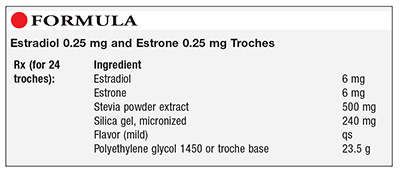US Pharm.2014;39(9):61-62.

Method of Preparation: Note—Owing to the variety of molds used for troches, the specific mold being used to compound this preparation must be calibrated to accommodate displacement of the troche base by the powders.
Calculate the quantity of each ingredient for the amount to be prepared. Accurately weigh or measure each ingredient. Mix the estradiol and estrone with the silica gel, followed by the stevia powder extract. Melt the polyethylene glycol (PEG) 1450 (or a commercial PEG troche base) and heat to about 50°C to 55°C. Slowly sprinkle the powders onto the melted base; mix thoroughly. Add flavor, mix well, pour into molds, and allow to cool. Package and label.
Use: Estradiol and estrone troches are used for hormone replacement therapy.
Packaging: Package in tight, light-resistant containers.
Labeling: Keep out of reach of children. Discard after ____ [time period].
Stability: A beyond-use date of up to 6 months may be used for this preparation.1
Quality Control: Quality-control assessment can include weight, specific gravity, active drug assay, color, texture–surface, appearance, feel, melting test, dissolution test, physical observation, and physical stability.2
Discussion: Estradiol (beta-estradiol, C18H24O2, MW 272.38) is a steroidal estrogen occurring naturally as white or creamy-white, small crystals or as a crystalline powder. Estradiol is odorless and hygroscopic; it is practically insoluble in water, but has a solubility of about 35.7 mg/mL in alcohol at 25°C and is sparingly soluble in vegetable oils. It should be stored in tight, light-resistant containers. Estradiol is generally not used orally, owing to extensive first-pass hepatic metabolism; in oral form, absorption across the oral mucosal membranes can occur.3-5
Estrone (Theelin, C18H22O2, MW 270.37) is a naturally occurring steroidal estrogen prepared from the urine of pregnant mares or from the Mexican yam (Dioscorea villosa). It occurs as small, white crystals or as a white to creamy-white, crystalline powder that is odorless and practically insoluble in water. Estrone is soluble to the extent of 4 mg/mL in alcohol and is soluble in vegetable oils. It is commercially available as an injectable suspension of 5 mg/mL.5
Stevia (honey leaf, yerba dulce) powder is a relatively new sweetening agent that is extracted from the leaves of the Stevia rebaudiana Bertoni plant. It occurs as a white, crystalline, hygroscopic powder. Stevia is natural, nontoxic, and safe and may be used in hot and cold preparations.6
Silica gel, a form of silicon dioxide, is obtained by insolubilizing the dissolved silica in sodium silicate solution. If obtained by adding sodium silicate to a mineral acid, it is called silica gel; if obtained by destabilization of a solution of sodium silicate to yield very fine particles, it is called precipitated silica. Silica gel occurs as a fine, white, hygroscopic, odorless, amorphous powder with a usual particle size of 2 to 10 microns. It is insoluble in water, alcohol, and other organic solvents, but is soluble in hot solutions of alkali hydroxides. Silica gel is used as a desiccant, suspending agent, and viscosity-increasing agent.7
A mild flavor is suggested that will not excessively stimulate salivation and cause too-rapid dissolution and swallowing of the drug. Absorption through the oral mucosa will minimize the first-pass effect that results when the drug is swallowed and goes into the systemic circulation from the small intestine.
PEG (Carbowax, polyoxyethylene glycol) is an addition polymer of ethylene oxide and water. The density of solid PEGs ranges from 1.15 to 1.21 g/mL. The melting points of PEG 1000, 1500, and 1540 are 37°C to 40°C, 44°C to 48°C, and 40°C to 48°C, respectively. All PEGs are soluble in water and miscible in all ratios with other PEGs. Solid PEGs are soluble in acetone, dichloromethane, ethanol, and methanol and slightly soluble in aliphatic hydrocarbons and ether; they are, however, insoluble in fats, fixed oils, and mineral oil. PEGs are chemically stable, do not support microbial growth, and do not become rancid.8
A PEG troche base may be prepared using PEG 1000 (10 g), aspartame sweetener (20 packets), and flavor and food color as desired. Alternatively, a commercial product may be used.9
REFERENCES
1. U.S. Pharmacopeia 37/National Formulary 32. Rockville, MD: U.S. Pharmacopeial Convention, Inc; 2014:403-453,1496-1497.
2. Allen LV Jr. Standard operating procedure for performing physical quality assessment of suppositories, troches, lollipops and sticks. IJPC. 1999;3:56-57.
3. McEvoy GK, ed. AHFS Drug Information 2012. Bethesda, MD: American Society of Health-System Pharmacists; 2012:3144-3149.
4. Lacy CF, Armstrong LL, Goldman MP, Lance LA, eds. Drug Information Handbook. 13th ed. Hudson, OH: Lexi-Comp, Inc; 2005:549-553.
5. Hardman JG, Limbird LE. Goodman & Gilman’s The Pharmacological Basis of Therapeutics. 9th ed. New York, NY: McGraw-Hill; 1996:1411-1437.
6. Reynolds JE, ed. Martindale: The Extra Pharmacopoeia. 37th ed. London, England: Pharmaceutical Press; 2011:2337-2342.
7. Hapgood KP. Colloidal silicon dioxide. In: Rowe RC, Sheskey PJ, Cook WG, Fenton ME, eds. Handbook of Pharmaceutical Excipients. 7th ed. Washington, DC: American Pharmaceutical Association; 2012:198-201.
8. Wallick D. Polyethylene glycol. In: Rowe RC, Sheskey PJ, Cook WG, Fenton ME, eds. Handbook of Pharmaceutical Excipients. 7th ed. Washington, DC: American Pharmaceutical Association; 2012:585-591.
9. Allen LV Jr. The Art, Science, and Technology of Pharmaceutical Compounding. Washington, DC: American Pharmacists Association; 2008:189.
To comment on this article, contact rdavidson@uspharmacist.com.





